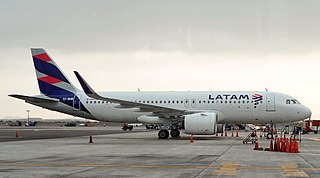Asiana Airlines Inc. is a South Korean airline headquartered in Seoul. In 2019, it accounted for 25% of South Korea's international aviation market and 20% of its domestic market. It maintains its international hub at Seoul's Incheon International Airport. and its domestic hubs at Gimhae International Airport in Busan and Gimpo International Airport in Seoul. It is a full-service airline and a member of Star Alliance.

Hiroshima Airport is an international airport in the city of Mihara, Hiroshima Prefecture, Japan. Located 50 km (31 mi) east of Hiroshima, it is the largest airport in the Chūgoku region. 80% of the airport's domestic traffic is to and from Haneda Airport in Tokyo. The Hiroshima-Haneda route is the fifth-busiest domestic air route in Japan.

Gulf Air Flight 072 (GF072/GFA072) was a scheduled international passenger flight from Cairo International Airport in Egypt to Bahrain International Airport in Bahrain, operated by Gulf Air. On 23 August 2000 at 19:30 Arabia Standard Time (UTC+3), the Airbus A320 crashed minutes after executing a go-around upon failed attempt to land on Runway 12. The flight crew suffered from spatial disorientation during the go-around and crashed into the shallow waters of the Persian Gulf 2 km (1 nmi) from the airport. All 143 people on board the aircraft were killed.

American Airlines Flight 1572 was a flight from Chicago O'Hare International Airport to Bradley International Airport on November 12, 1995. The McDonnell Douglas MD-83 struck trees and an instrument landing system (ILS) antenna during landing, causing $9 million in damage to the aircraft.

Armavia Flight 967 was a scheduled international passenger flight operated by Armavia from Zvartnots International Airport, Zvarnots in Armenia to Sochi, a Black Sea coastal resort city in Russia. On 3 May 2006, the aircraft operating the route, an Airbus A320-200, crashed into the sea while attempting a go-around following its first approach to Sochi airport; all 113 aboard were killed. The accident was the first major commercial airline crash in 2006. It was Armavia's only fatal crash during the airline's existence.

Philippine Airlines Flight 137 was a scheduled passenger flight from Ninoy Aquino International Airport in Manila to Bacolod City Domestic Airport in Bacolod.

Lufthansa Flight 2904 was an Airbus A320-200 flying from Frankfurt, Germany to Warsaw, Poland that overran the runway at Okęcie International Airport on 14 September 1993.

Indian Airlines Flight 605 was a scheduled domestic passenger flight from Bombay to Bangalore. On 14 February 1990, an Airbus A320-231 registered as VT-EPN, crashed onto a golf course while attempting to land at Bangalore, killing 92 of 146 people on board.

TACA Flight 390 was a scheduled flight on May 30, 2008, by TACA International from San Salvador, El Salvador, to Miami, Florida, United States, with intermediate stops at Tegucigalpa and San Pedro Sula in Honduras. The aircraft, an Airbus A320-233, overran the runway after landing at Tegucigalpa's Toncontín International Airport and rolled out into a street, crashing into an embankment and smashing several cars in the process.

FedEx Express Flight 80 was a scheduled cargo flight from Guangzhou Baiyun International Airport in the People's Republic of China, to Narita International Airport in Narita, Chiba Prefecture, Japan. On March 23, 2009, the McDonnell Douglas MD-11F (N526FE) operating the flight crashed at 6:48 am JST, while attempting a landing on Runway 34L in gusty wind conditions. The aircraft became destabilized at flare and touchdown resulting in an unrecovered "bounced" landing with structural failure of the landing gear and airframe, and came to rest off the runway, inverted, and burning fiercely. The captain and first officer, the jet's only occupants, were both killed.

On 22 December 2009, an American Airlines Boeing 737-800, operating American Airlines Flight 331 and carrying 148 passengers and six crew, overran runway 12 on landing at Kingston in poor weather. The plane continued on the ground outside the airport perimeter and broke apart on the beach, causing injuries.

UPS Airlines Flight 1354 (5X1354/UPS1354) was a scheduled cargo flight from Louisville, Kentucky, to Birmingham, Alabama. On August 14, 2013, the Airbus A300 flying the route crashed and burst into flames short of the runway on approach to Birmingham–Shuttlesworth International Airport. Both pilots were pronounced dead at the scene of the crash. They were the only people aboard the aircraft. It was the second fatal air crash for UPS Airlines.

Air Canada Flight 624 was a scheduled Canadian domestic passenger flight from Toronto Pearson International Airport to Halifax Stanfield International Airport in Halifax, Nova Scotia. During heavy snow and poor visibility, at 00:43 ADT on 29 March 2015, the Airbus A320-211 landed short of the runway and was severely damaged. Twenty-six people were injured.

Turkish Airlines Flight 1878 was an international passenger flight from Milan–Malpensa Airport, Italy to Atatürk Airport, Istanbul, Turkey. On 25 April 2015, the aircraft rolled sharply just before landing, causing a very hard touchdown resulting in substantial damage to the starboard wing and a fire. A go-around was initiated, and the aircraft positioned for a second approach attempt but veered off the runway on the second landing. All 102 passengers and crew survived unharmed.

The 2009 Aviastar British Aerospace 146 crash occurred on April 9, 2009, when a British Aerospace 146 crashed into Pikei Hill during a ferry flight from Sentani Airport to Wamena Airport, both in Indonesia's Papua province. Due to the force of the impact the aircraft was destroyed and all 6 crew members were killed. The aircraft was carrying voting paper to Wamena as well as several other goods, as a parliamentary election was held in the month. The wreckage was found in Pikei Hill, Tengah Mountain, Tangma, Yahukimo District.

On July 7, 2017, an Airbus A320-211 operating as Air Canada Flight 759 was nearly involved in an accident at San Francisco International Airport in San Mateo County, California, United States. The flight, which originated at Toronto Pearson International Airport, had been cleared by air traffic control to land on runway 28R and was on final approach to land on that runway; however, instead of lining up with the runway, the aircraft had lined up with the parallel taxiway, on which four fully loaded and fueled passenger airplanes were stopped awaiting takeoff clearance. The flight crew initiated a go-around prior to landing, after which it landed without further incident. The aircraft on the taxiway departed for their intended destinations without further incident. The subsequent investigation by the National Transportation Safety Board (NTSB) determined that the Air Canada airplane descended to 59 feet (18 m) above the ground before it began its climb, and that it missed colliding with one of the aircraft on the taxiway by 14 feet (4.3 m).

Iberia Flight 1456 was a domestic scheduled flight from Barcelona-El Prat Airport, Spain, to Bilbao Airport, Spain. On Wednesday, February 7, 2001, the Airbus A320, which took off from Barcelona-El Prat Airport, Spain, encountered a microburst-induced wind shear on final approach to Bilbao Airport, Spain. The wind shear caused the plane's landing gear to collapse. All 143 passengers onboard survived; with 25 people suffering light injuries, and 1 person receiving serious injuries. The aircraft was irreparably damaged as a result of the ordeal and was decommissioned soon after, making it the ninth loss of an Airbus A320 at that time. This accident prompted Airbus to develop a fail-safe modification for its flight control software by preventing the airplane's built-in protection against stall from being activated by a high rate of change for the angle of attack.

LATAM Airlines Perú Flight 2213 was a scheduled domestic passenger flight in Peru from Lima to Juliaca. On 18 November 2022, the Airbus A320neo was taking off from Jorge Chávez International Airport when it collided with a fire engine that was crossing the runway, killing two firefighters and injuring a third, who died of his injuries seven months later. 40 passengers were injured. The aircraft was damaged beyond repair and written off, making it the first hull loss of the Airbus A320neo family.



















